The Starting Point: A Meeting in Schenectady |
|
|
| Credit: Schenectady Gazette, November 20, 1950 |
|
The year was 1950, the beginning of everything. In an inner-city park in upstate New York, close to a hundred runners took the gun and started off in a race that would forever change the landscape of interscholastic sports. The event, the first annual New York State Public High School Athletic Association (NYSPHSAA) Cross Country State Championship, had a beginning spun from dreams and a result that literally hung by a shoestring. But the approximately 200 runners who ran in the two races on November 18, 1950 blazed the trail for later generations of HS athletes in all sports, and maybe even for the half of the state schools' student body that were barred from competing in interscholastic sports. A 2.2-mile journey by a few dozen guys has rarely been completed that affected the lives of so many others. The story of the initial XC Class A race -- a close, wild, hard-fought, somewhat controversial affair -- and the year that led up to the State championship would set the tone for the meets and feats of the following decades. Along with the guys in the Class B race, the 1950 harriers would get New York off and running to the then unimagined triumphs of today. Much of the story of the race and the quarter-century of running leading up to it has been lost over the intervening years, but enough of the tale remains to hang it high in the rafters of NY high school running lore.
Some of the ideas of the early to mid 1900s may seem wrong-headed and even a little shocking to modern HS athletes. But in a current age when there is concern about overuse injuries in young athletes, gender-related health issues for many sports activities, and sports-related behavioral problems, we should remember that we are still learning how to deal with many of the same dilemmas that earlier generations wrestled with. Looking back today over more than 6 decades of the New York States Cross Country Championships, all we can say to the participants of the first meet is, "Good start" and "Thanks." Setting UpWith the 1950 meet, cross-country became the first public high school sport to have a statewide championship established that would become an unbroken string of annual events to the present day. More than 40 years before the NYS football teams would initiate a championship system in 1993 that pulled together the teams above New York City, runners from 7 section conferences gathered in Schenectady to kick off the era of the NYSPHSAA State Championship meets that would eventually lead to today's 33 or so state finals in boys and girls sports. But the 1950 meet was not really the first intersectional XC meet in New York. Running had been a popular high school activity since the early 1900s, and large invitational meets and county championship meets had been held around the state for many years. The boom in scholastic sports had led the NY public schools in the early 1920s to mirror the college regional section setup. The first public school sectional arrangement had 14 groups and also included New York City schools. A later set up formed 8 sectional athletic conferences to represent regions outside of New York City, a number that would soon grow to 10 and finally culminating in 11 with the split of Long Island in 1957. There were also national scholastic regional sections, and NY's football powerhouses in the 1920s such as Mt. Vernon and Manlius Academy would travel to Philadelphia or Washington, D.C. to represent the East section for US schools. In 1923 the NY schools decided that further controls were needed for sports, and the NYSPHSAA was formed to provide a central management role. Starting in 1924, intersectional championships for cross-country were an annual event, and often were held upstate in the central region stretching from Albany to Schenectady to Syracuse. Union College was a national XC power at the time, and the high school championships were often held at colleges such as Rennselaer Polytechnic Institute or Hamilton in an area where the running craze had settled in big-time. An innovative coach Bill Eddy of the Schenectady HS and later the Nott Terrace cross country and track teams not only copped a string of national titles but also graduated a number of athletes who would spread his running fundamentals as coaches at other high schools and colleges in the region. Eddy's teams made trips down to "Gotham" to compete in big races against the NY City region schools such as Curtis and New Rochelle. Winning the huge (but not 40-races huge) Manhattan College race that began in 1925 became an annual achievement for the Schenectady teams, with Nott Terrace later "retiring" championship cups such as the Kirby trophy for the Columbia University meet after winning them for a third consecutive year. The legions of Dorpian runners from Schenectady HS and Section 2 also won the early NYS XC championships because there was no school at the state or national level that could compete at that level. With many newspapers providing passionate coverage of the local scholastic teams and an almost endless supply of new sports such as lacrosse for New York schools to dive into, the state sports scene looked ready to explode. Besides cross country, sports such as baseball, hockey, swimming, and tennis held State championships, and though opportunities in interscholastic sports for girls were limited, even they had a state championship tourney in basketball set up. Interscholastic cross country fever continued to grow, though the teams competing for national titles in big meets at Villanova University and Newark, New Jersey, were largely all from the Northeast and Mid-Atlantic regions. The paths for XC popularity seemed endless, and 80 years before a girls team from Fayetteville-Manlius HS in NY was dominating national competition, the boys team from Schenectady was doing the same. However, as the saying goes, enjoy the great feeling while it lasts. The bubble for much of NY interscholastic sports was about to burst. Getting Back to the Starting Line at the StatesThe early years of the NY state intersectional championships ended in the early 1930s, right with the advent of the Great Depression. In an era of straitened financial circumstances and rising concern about the ever increasing role and emphasis of sports at schools, the state's athletic organizations through the NYSPHSAA banned the State championships, leaving Sectional tournaments as the highest level of scholastic sports for most athletes. Even the sectional meets started to lapse in most areas.The athletes most harshly affected by the new strictures were the girls, who not only had their State basketball championship taken away but were also soon barred from playing in any interscholastic sports. School officials clearly felt that any competitive sports activities for girls were unhealthy. Four decades would pass before girls would again make an appearance in a state championship, and this time it would start with the runners in track and cross-country. |
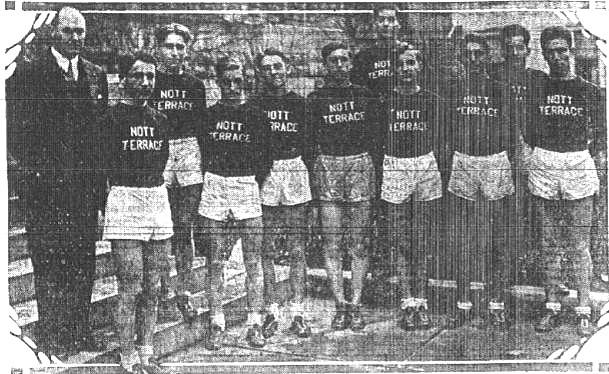 |
|
---Nott Terrace Cross Country team in 1932. Coach Bill Eddy is at left. Star runner and future coach Ray Vacca is next to him. |
| Credit: Schenectady Gazette, October 1932 |
|
The era without State championships in New York continued for nearly two decades, but the running competitions for the top boys stayed highly competitive in the NYC-Schenectady-Syracuse axis, as the advent of the age of big invitational meets began in earnest. In 1931, Schenectady HS split into Nott Terrace HS and Mont Pleasant HS. Bill Eddy's Nott Terrace team would continue to win most of the Eastern and national titles throughout the decade, including 7 straight Manhattan Invitational wins between 1934 and 1940, but cross-town rival Mont Pleasant coached by Norm Kitching pulled some early upsets on NTHS, and led by repeat national champion harriers Steve Szumachowski and then Ray Trail, the Red Raiders generally finished right behind Eddy's runners in the big competitions. |
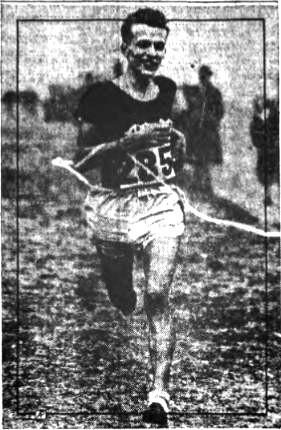 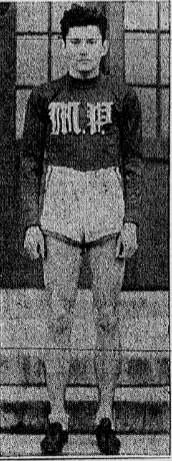 |
| ---Mont Pleasant national champions Steve Szumachowski and Ray Trail |
| Credit: Schenectady Gazette, November 1932 and November 1936 |
|
By the end of the 1930s, new XC meets were beginning to rise to the forefront of NY and Eastern competitions. In 1938, the New York University Spiked Shoe meet started attracting the top schools to gather in late October at the famed Van Cortlandt Park course, and Nott Terrace ran off with 3 of the first 4 titles. The Schenectady schools started the Grout Invitational in 1939 on a course covering a little over 2 miles at the city's Central Park in mid November. Surprisingly, neither of the city's powerhouse teams were able to win any of the first four Grout Meets, as rising powers Eastwood HS of Syracuse, Newtown HS of Long Island, and Bishop Loughlin Memorial HS of Brooklyn took the titles. Nott Terrace was the perennial Grout runner-up until breaking through for championships in 1943 and 1947. Teams that won the Grout often went on to win the Eastern Intersectional national championship held each Thanksgiving Day at the Branch Brook Park course in Newark, NJ, or Seton Hall University in South Orange, NJ. One other upstate meet that became prestigious was the Proctor Invitational (EJ Hermann) begun in Utica in 1941 and won by the host Proctor HS the first two years and then by Nott Terrace for 11 of the next 14 meets. By the early 1940s, Bishop Loughlin had risen to the top of NY's XC and track world, running off impressive victory streaks in the big meets, including 7 Grout championships between 1941 and 1950. Syracuse Eastwood and Syracuse Central high schools also began to make their mark along with NYC schools Curtis HS of Staten Island and Brooklyn Automotive Technical School. By the late 1940s, the growth of the NYC suburbs began to fuel the rise of teams such as Sewanhaka and Port Jefferson on Long Island and New Rochelle and Gorton (Yonkers) in Westchester County. In the post World War II era, a new focus on interscholastic athletics began to emerge as a baby boom occurred and young families looked for good opportunities for their kids to excel in. Bill Eddy retired from Nott Terrace coaching duties to become the Schenectady superintendent of parks and recreation following the 1947 season after one more great year for the Blue Devils that included Grout and Manhattan wins and a 2nd place at Nationals to Bishop Loughlin. But Eddy had a final great vision of bringing back the NY State Intersectional Championship and hosting it like the Grout on his city's Central Park course. Upstate teams had held Eastern New York or Northern New York championships in the 1940s, and Section 2 had revived its own sectional championship in 1948 after a long hiatus. But the Section 2 meet mainly just featured contests between many different level squads from Nott Terrace and Mont Pleasant, designated A for the top squad through G for the lowest level runners. Eddy thought the state was ready to bring the public schools together for a meet that would feature hard-fought affairs between the best runners and teams from all the sections. Support for the idea was pulled together, and intersectional committee was formed that included a member from all 8 sections that participated in cross country. Howard Wescott, the Schenectady schools' physical education supervisor represented Section 2 as the committee chairman, and other members were Arthur Lynch (Bronxville, Sect. 1), Eliott Hunt (Utica, Sect. 3), Sidney Stock (Vestal, Sect. 4), Don Munson (Snyder, Sect. 5), KC Hausner (Port Henry, Sect. 6), Herbert Williamson (Valley Stream, Sect. 8), and Edward Kincaid (Congers, Sect. 9). The Intersectional Meet Committee would put together a structure for the initial meet that basically still stands today. First, the members decided to follow the two-tier race system used in Section 2's meet and split the competition between an A race for large schools and a B race for small schools. Each section was to select one team of 7 runners to represent it in a team competition, plus up to 7 more at-large runners who would compete along with runners from the selected team in an intersectional contest. All runners were eligible to win the third title, the individual crown. Each runner would wear a special meet shirt with a shield logo and the names and the assigned color of their section, which for Section 1 was light blue and Section 2 was maroon, and so on. It was perhaps a given from the beginning that the meet would be held at the fairly central NY location of Central Park in Schenectady, for which Bill Eddy was now the supervisor. The first five State meets would eventually be held there. There were also a few meet details that were a bit different from the modern format. The score in the Sectional competition at States would be determined by the placements of the top 10 runners from each section's team of 14 rather than 12, and the Sectional competition was considered at least as important as the Team competition, while today the Section scores are hardly even noticed. The top 10 runners in each race received a fist-sized "Oscar," or trophy, while the winning Team squads received tie clasps (yes, kids wore ties back then), the winning Section squad's top 5 finishers received medals, and a big trophy was given to the champion A and B teams. A mobile broadcast unit was to be set up in Central Park to provide radio coverage of the meet. One detail was a little fuzzy. The Team score was to be determined by the placement of the top 5 runners of each team, but what was not fully specified was whether all of the at-large runners in a race would count or just the ones competing for the official 7-member teams. This question may have loomed large in the controversy that would mark the 1950 Class A race. And the man who would have to sort out the scoring issues on race day would be Bill Eddy. |
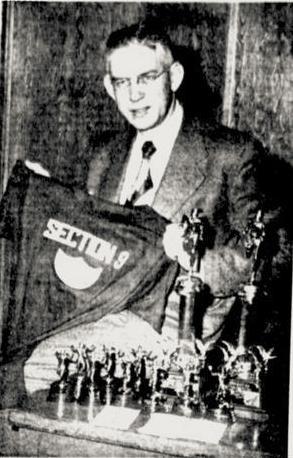 |
| ---Intersectional Championship Committee Chairman Howard Wescott with 1950 meet shirt and awards |
| Credit: Schenectady Gazette, November 16, 1950 |
|
With everything pretty much set, all that was left to do was to find out which teams and runners would be appearing at Central Park on November 18, 1950 to battle for the championships. A Season of ChangesWhen the New York State cross country season kicked off in October 1950 after the usual competition-less September training period, there were a few elements that seemed likely to stay the same and a few others that were signals to a whole new era. On the same-old, same-old side, Nott Terrace remained as the favorite to win the State public schools' championship, though the Blue Devils were on their 3rd coach in 4 years, after former scholastic NTHS and Manhattan College star Ray Vacca took over for Bill Eddy in 1948 and then moved on to Mont Pleasant for 1949. Bill Leonard was now coach of Nott Terrace, and even though his team team had lost its top 3 to graduation, it continued to be the dominant force among the NYSPHSAA schools coming off a 3rd place at the Eastern Interscholastics behind non-NYSPHSAA schools Bishop Loughlin and Brooklyn Automotive in a meet that was still seen as a national championship contest. Vacca's Mont Pleasant team looked to be the Blue Devils' main competition after a 12th place at the Easterns in 1949 and with the expected emergence of the top returning local runner, junior Eddie Alger. Outside of the NYSPHSAA teams, NYC Catholic school power Bishop Loughlin was set to once again be the top team in the nation. |
 |
| ---Nott Terrace (Schenectady) 1950 Cross Country team, with Coach Bill Leonard at right in front row. |
| Credit: Schenectady Gazette, November 11, 1950 |
|
But some huge changes were also underfoot. The schedules of the NYSPHSAA teams now revolved around preparations for the Sectional State Qualifier and the Intersectional Championship meets. Big invitationals such as the Grout and NYU Spiked Shoe were still important dates, but the State Meet was now the featured finale to the season, sparked in part by the crowded conditions at the Eastern Intersectionals. In 1949, 350 runners packed in at the Seton Hall course had a frustrating time bunched up in tight sections, and some coaches felt the meet had grown too big. Another area of change was that schools from outside Section 2 were starting to look like potential challengers to Schenectady's top duo. Sewanhaka of Long Island's Section 8 had finished 4th at the Grout in 1949, just 2 points behind Mont Pleasant. The Syracuse schools of Eastwood and Central were strong teams for Section 4 along with Vestal, and Utica Proctor of Section 3 was a perennial power. The situation for the Section 1 teams from Westchester was less clear, but the track enthusiasts from the Schenectady area had been very impressed by a runner from Rye named Tommy Deans who had run a 4:24 mile in a track meet there that spring. So there was a great deal of excitement and anticipation as the NYS teams did their training runs and began their drive toward the initial States meet in October 1950. The first big competition of the season was the Proctor Invitational (EJ Hermann) meet in Utica on October 7, and a small surprise was served up as Mont Pleasant edged 6-time defending champion Nott Terrace by 59-61. The other teams were far back, with Vestal a distant 3rd with 122 points and host Proctor even further back in 8th. MP's star Eddie Alger was beat out by Section 2 small school Watervliet's Johnny (Jack) Hughes. NT placed their top 3 of Johnny Chillrud, Warren Harding and Johnny Parillo in the top 11 spots, while MP's Don Lesperance finished 7th. The following Saturday on October 14, the prestigious Grout race was held, and it served as kind of a pre-States review run for the teams that would be at the Intersectional Championship set for 5 weeks later in Schenectady's Central Park. A new 2.2 mile course had been set up for the Grout, and it would also be used for the Section 2 State Qualifier and the State Championship meets. As expected, Bishop Loughlin of Brooklyn won its 3rd straight title and its top runner Bob Kubic beat out a 3rd place Jack Hughes of Watervliet for the championship in a time of 11:28. Bronx Catholic school Cardinal Hayes placed 3rd and their top runner, Wilfred Sterz, was 2nd. But the results between the two Schenectady schools were reversed from the Proctor meet, as Nott Terrace took 2nd with 87 points and Mont Pleasant was 4th with 97. Other notable team finishes included Monticello of Section 9 just 1 point behind MP in 5th, Waterford of Section 2 in 8th, and Utica Proctor in 9th. MP's Eddie Alger finished a close 4th, and other runners at the top included Monticello's Tom King and John Smith in 5th and 8th, Bob Jackson of Waterford in 9th, Don Lesperance of Mont Pleasant in 10th, and Nott Terrace's Johnny Parillo in 11th. |
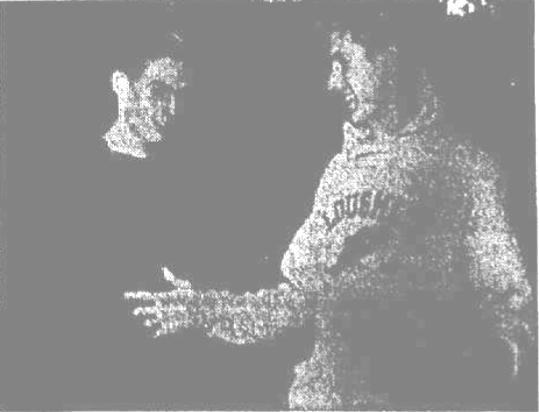 |
| ---Bishop Loughlin's Bob Kubic, winner at the 1950 Grout Meet, discusses the race with Mont Pleasant 3rd-place finisher, Eddie Alger. |
| Credit: Schenectady Gazette, October 16, 1950 |
|
The following Saturday the top teams headed to Van Cortlandt Park in the Bronx for the NYU Spike Shoe Invitational. Though a NYC public school teachers strike kept many city schools from the meet, defending champion Bishop Loughlin had no difficulty winning the title with only 69 points, as top runner Bob Kubic finished 2nd to Henri Geller of Poly Prep of Brooklyn, who ran a 13:36 over a 2.5 mile VCP course. For the NYSPHSAA teams, however, the status for the States title quest was flipped again as Mont Pleasant finished a strong 2nd with 107 points, and Nott Terrace was back in 3rd with 142. Other notable team finishes included Section 1 schools Gorton of Yonkers in 8th and New Rochelle in 10th, with the latter totalling 309 points. Among the names included in the top 25 finishers were New Rochelle's lead runner Greg Dillon in 4th and Jerry Utter in 8th; Mont Pleasant's Ed Alger, Don Lesperance, and Ernest Weeks in 6th, 16th, and 23rd; and Nott Terrace's John Chillrud and John Parillo in 9th and 15th. As November rolled around, teams began to prepare for their Sectional State Qualifier meets. Mont Pleasant got one last shot at fine-tuning by winning the Waterford Invitational on October 28, as the Red Raiders' Eddie Alger took 1st, and Utica Proctor finished 3rd and host school Waterford 4th. It would be the last meet before qualifiers, because of a shockingly bizarre action at the Fordham University Invitational meet on November 4 at Van Cortlandt Park. More than 70 teams including Mont Pleasant, Nott Terrace, and defending champion Bishop Loughlin gathered at the park and waited two hours in a driving rainstorm before meet officials called it off due to treacherous conditions. Lest any of the old time runners start to reminisce about how much harder they had it back when harriers were real men, remember that meets did get cancelled back then because of a bit of wetness. The runners got back in the buses and headed home. The Sectional qualifiers to decide which teams and runners would represent each section in the Class A and B races were held on Saturday, November 11, at 7 different courses. For most of the sections, the only information available about the qualifier results was which school won the States berths. In Section 1, New Rochelle led by star Greg Dillon beat Gorton and Roosevelt of Yonkers in Class A, and Pelham won for Class B. Section 2 saw a changing of the guard in a cold morning meet on the Central Park States' course as Mont Pleasant thrashed Nott Terrace 33-59 to win its first Sectional title, and MP's Eddie Alger set a course record in 11:20, a big 8 seconds better than the Grout winning time. Nott Terrace's Johnny Parillo finished 4th, and all 7 of the NT varsity runners won berths on the Section 2 States A squad. Waterford's Bob Jackson finished 3rd and led his team to the Section 2 B title. Glens Falls' John Williams was 2nd in the race and Watervliet's Jack Hughes finished 5th to qualify for Class B States berths. |
 |
| ---Mont Pleasant High School (Schenectady) 1950 Cross Country team with Coach Ray Vacca at left in front row. |
| Credit: Schenectady Gazette, November 13, 1950 |
|
Details for the other sections are more sketchy. In Section 3, Proctor of Utica was the Class A winner, and New Hartford won Class B. Vestal beat out the big Syracuse schools for the Section 4 A title, and Delhi took the B crown. Though Section 5 was involved in planning the meet, it would not send any teams or runners to States until 15 years later. The Section 6 winners were Amherst in Class A and Silver Creek in B. Section 8 sent a rising power Sewanhaka team for the A race and Riverhead for the B. Section 9's representatives were Middletown in Class A and a very strong Monticello squad for B. Sections 7 and 10 were not part of the XC championship scene, and Section 11 would not be split off from Section 8 for another 7 years. The teams for States were set. On the third Saturday in November, runners from 7 sections and 60 different teams gathered in the afternoon at Central Park. At 2:00, the guys for the A race leaned forward to await the gun from the starter, Nott Terrace coach Bill Leonard. The Return of the ChampionsAny knowledgable fans waiting for the Class A runners to take off could have been forgiven for thinking that the race was just a coronation party for the local Schenectady harriers. Mont Pleasant and Nott Terrace had proved themselves to again be the best public school teams in NY, and though only one of them could run for the Team title, the combined power of the two squads made the Section title in Class A a certainty for Section 2. There was only one other team at the meet besides Nott Terrace that had shown itself to be able to challenge Mont Pleasant, and that was Monticello from Section 9, the big favorite in the Class B race. Schools that had recent success in past years such as Sewanhaka and Utica Proctor were not strong in 1950. Vestal was relatively tough, but it had finished a distant 3rd to Mont Pleasant at the Proctor Invitational. Section 1's champion New Rochelle had faced MP at the NYU Spiked Shoe meet and the Huguenots had been outscored by 107-309, so enough said about that. The individual title was more in doubt because MP's Eddie Alger had been beaten by 9 seconds by New Rochelle's Greg Dillon four weeks before at the NYU meet, but Alger had set a course record the week before at Central Park and was now the favorite. No team appeared to have anything close to the depth of Coach Ray Vacca's Red Raider squad of Alger, Don Lesperance, Bill Cote, Ernie Weeks, Paul Lusk, Wayne Erb, and Barrie Gray. |
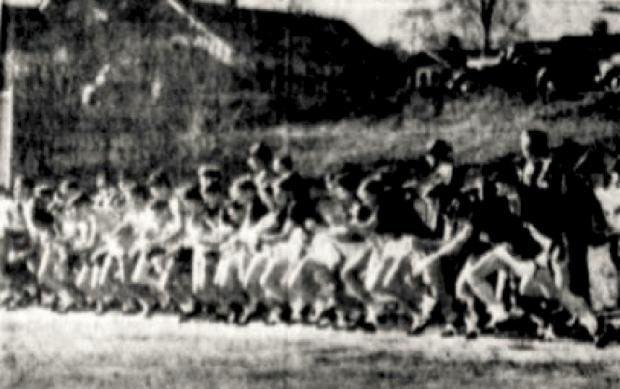 |
| ---Start of the Class A race in smaller view with Section 2 runners in dark jerseys at right getting the jump. |
| Credit: Schenectady Gazette, November 20, 1950 |
|
When Bill Leonard fired the starting gun, the 7 colors of shirts started to mix together, and with them the identities of the runners who would be noted in the record books. What is known is that the maroon jerseys of Mont Pleasant and Nott Terrace quickly moved up toward the front and appeared to take control of the Sectional contest. The Red Raiders also seemed to have the Team title tucked away with Alger up among the top 5 runners, Lesperance and Weeks strong in the top 25, and Gray and Cote a few places back in the low 30s. Vestal had their top guys Jim Howard and Jim Clubb among the leaders and #3 guy Bob Ward in the top 25, but they did not have enough depth at the back. New Rochelle was doing far better than expected with Greg Dillon at the front, Jerry Utter in the top 10, and Charles Nelson in the top 15, but they were still running behind Mont Pleasant. All seemed to be going pretty well for the Red Raiders, but with a mile to go, things unravelled for them and New Rochelle got its chance. Mont Pleasant's Ernie Weeks was normally further back among the runners on Vacca's squad, but at States he had forged up close to #2 runner Don Lesperance at the halfway point. Shortly afterward, the laces on one of his shoes came loose and he soon was running with one foot bare. The chance for a top 20 place was gone as he drifted back toward what would ultimately become a 28th place. Meanwhile, Dillon broke away from a group that included Alger along with Middletown's Victor Oliver and Vestal's Howard and Clubb. The New Rochelle frontrunner sped to the finish in a new course record of 11:18 to win by 4 seconds. The previous record owner Alger fell back to 4th behind Oliver and Howard and one place ahead of Clubb. Russ Bradshaw of Fulton in Section 3 took 6th, but then two more light blue jerseys crossed the finish line with Utter giving New Rochelle a key 7th place and John Dowd of Yonkers Roosevelt finishing 8th. The last two Oscar trophies were claimed by Nott Terrace's John Parillo and Bill Patton of Hicksville earned Section 8's first placing in 10th. |
 |
| ---New Rochelle's Greg Dillon wins the 1950 Class A race in course record time. |
| Credit: Schenectady Gazette, November 20, 1950 |
|
As the light blue Section 1 jerseys continued to filter in among the Section 2 maroon shirts, even the Sectional title began to look a little more in doubt. Charles Nelson took 13th to give New Rochelle a third runner in before Mont Pleasant's second, and Walt Bretnall of Gorton gave Section 1 another good place with a 15th. It wasn't until Roger Grice and Warren Harding of Nott Terrace took 18th and 19th and Don Lesperance gave Mont Pleasant its 2nd runner in at 21st that Section 2's chances began to seem more secure. But as the runners poured across the line, the question of which team had won the race was very much in doubt. As the last Class A runners finished up a little before 2:15, the official scorer Bill Eddy got to work trying to untangle the results and declare a winner. But while the Class B runners lined up for their race, the final decision on the Class A was still 2 hours away. Whether the scoring difficulty Eddy was wrestling with involved the question of which tallying system would be used -- all runners or just team runners -- is unknown, but three different results would be announced before the fourth and last decision would be set in stone. Monticello of Section 9 left little doubt about who was the top small school as they placed 5 runners in the top 25 of the Class B race and also took control of the Sectional contest. The team's top duo of Tom King and John Smith finished 5th and 9th, and Steve Murran, Mike Tutsi, and Frank Lauferswiler placed 18th, 22nd, and 25th to earn a 37-56 decision over Riverhead. The Long Island school finished Al Brown and William Lucas in 13th and 14th to propel them into the runner-up spot. Pelham of Section 1 placed Eph Klotts in 10th and finished 3rd with 73 points. Bob Jackson of Waterford finished 4th and led his team to a 4th place, and Delhi, Silver Creek and New Hartford finished 5th through 7th. The battle for the individual championship in Class B turned out not to be close as expected. Jack Hughes of Watervliet and Tom Deans of Rye had been co-favorites going in, but Deans ran 11:23 and won by 10 seconds over Silver Creek's Pete Bifaro, with Hughes taking 3rd. Other top 10 runners included Don Farley of Bronxville in 6th, George Turner (1951 Class B champ) of Arlington in 7th, and John Williams of Glens Falls in 9th. Section 9's Sectional triumph was built on not only the champion Monticello squad but also the 11th place of Orville Myers of Walkill and 23rd of Bill Klopchin of Congers. |
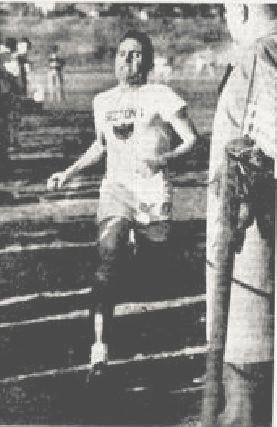 |
| ---Rye's Tom Deans takes the 1950 Class B race. |
| Credit: Schenectady Gazette, November 20, 1950 |
Back at the scorers table with the Class B championship already determined, Bill Eddy and his assistants were still trying to figure out who won the Class A race. The scoring totals show that the scoring method used was to only count the 49 runners from the 7 squads running for the Team title. After an initial tally, the decision was announced that the result was a tie between Mont Pleasant and New Rochelle, and that meant co-champions since no 6th man tie-breaker rule was used back then. However, as both schools were congratulating each other, a recount was made and New Rochelle was announced as the sole champion. But a further tallying switched the decision in Mont Pleasant's favor. Finally (and I mean finally), at around 4:15 with the sun getting low in the sky, the New Rochelle runners got to celebrate as they were awarded the championship trophy based on a 59-60 final score, a monumental upset. The race had lasted around 12 minutes, but the final decision had needed about 120. Mont Pleasant would get some satisfaction for being part of the Section 2 squad that beat Section 1, 222-260. After a likely fairly hasty awards ceremony, the visiting teams climbed back on the buses and headed home. The first NYSPHSAA Cross Country Championship had had a few awkward and likely a lot of heartbreaking moments, but overall it had been a spectacular success. The runners would return to Central Park for the State Championship in 1951, and this time the hometown heroes Mont Pleasant would win the Class A title by 11 points over Sewanhaka, while Arlington of Section 1 would claim the B title. After three more championships on the same course, the venue would move to Bear Mountain State Park in 1955, and Vestal would win the last of its 3 straight Class A titles. Mont Pleasant made a final appearance at the State meet and won the Class A title in 1958. Nott Terrace got one chance to win a State title on its hometown course in 1953 and came in 3rd, but before the school was closed down in 1958, the Blue Devils shot off a grand finale for their storied program by winning the 1956 and 1957 NYS Class A championships. In 1960, the NYS championships would expand to three classes. In 1975, following an earlier resumption of interscholastic athletics for students of all genders, the girls would run in their first State Cross Country Championship, and Kathy Mills from Fayetteville-Manlius won the race. Some things never change. |
.jpeg) |
 ---Start of the Class A race in 1950
---Start of the Class A race in 1950.jpeg) The forces that brought together the runners for the two pioneering races in Schenectady were unleashed from a variety of new developments in American social and financial trends, changing state demographics, and shifting ideas about participation in sports. The event followed upon decades of changes in the country's running scene, and public perceptions on athletics were fast being altered in the mid-20th century. A meet that had been terminated years before had overcome the opposition and was about to begin anew.
The forces that brought together the runners for the two pioneering races in Schenectady were unleashed from a variety of new developments in American social and financial trends, changing state demographics, and shifting ideas about participation in sports. The event followed upon decades of changes in the country's running scene, and public perceptions on athletics were fast being altered in the mid-20th century. A meet that had been terminated years before had overcome the opposition and was about to begin anew.